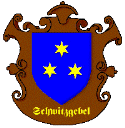Schwitzgebel Origins
The Family Name
According to tradition, the name Schwitzgebel originated in Switzerland and is first documented in Lauenen and Saanen in 1494, where it is reported that an immigrant, whose name was Gabriel and who had come from Canton Schwyz, was nicknamed Gäbel. "Schwyz Gäbel" evolved, then, to Schwitzgebel. Later, there are mentioned Jakob, Kastlan (warden of a castle) 1692 and 1790; and Ulrich, Landsvenner (Official) 1816 and 1820.1
There are also numerous variant spellings of the name at that time, owing to regional prevalence of French or German in various parts of Switzerland and to the relatively recent emergence of literacy. For instance, in the Saanen Taufrodel (baptismal records) is the entry, dated 7 January 1621, for Peter Werde von Grueningen and Catharyna Schwitzgäbell whose son, Peter, was baptised 27 April 1623 (volume 4, page 222).
A Schwitzgebel Coat-of-arms
In Familienwappen der Landschaft Saanen, the Schwitzgebel coat-of-arms is described on page 23 as „Wappen: in blau drei grosse goldene sterne“.
The author goes on to state that „Has im Landhaus
Saanen 1909 aufgemalte wappen: Zwei gebreuzte Gabeln über
einem Dreiberg ist eine Erfindung des Malers“. That is, "A
coat of arms painted in the 'Saanen' country house in 1909, depicting
two crossed forks over three mountain peaks, was the artist's
invention." 

At left is depicted a Schwitzgebel coat-of-arms as interpreted by Robert Marti-Wehren in his pamphlet, Familienwappen der Landschaft Saanen
The
illustration at right is based on the arms of Schwitzgebel of
Saanen as it is illustrated in Heraldica Helvetica (Francois
Rippard, 1993). I'm told by a heraldry expert that this interpretation
of the in blau drei grosse goldene sterne blazon more
accurately reflects standard heraldry conventions.
Another pamphlet by Robert Marti-Wehren on Hausinschriften aus Saanen contained references to the following inscriptions:
- In the local dialect, „Hans Schwitzgebel het ditz Hus gebuewen uf Got den Heren stat sin vertruwen im 1647 Jar“. Or, "This house was built by Hans Schwitzgebel, with faith in almighty God, in 1647."
- On page 16 of the same pamphlet is a rather lengthy inscription, dated 1791, reading in part: „Auf Gottes segen und vertrauen hat Hans Peter Schwitzgebel, Lieutenant und Trüllmeister, und Catharina Jaggi diess Haus lassen bauen“. Or, translated, "With faith in the Lord and his blessings, Lieutenant and Drillmaster Hans Peter Schwitzgebel and Catharina Jaggi built this house."
Family History On A Platter
 |
| Another version of the Schwitzgebel wappen. Which is right? |
In early 2002, Herb Schwizgebel, of Canada, forwarded to me an e-mail note with an image of a painted platter attached. The platter, which belongs to the mother of René Meier, of Switzerland, has the following inscribed on the back:
„Schwizgebel ist ein altes Berneroberländergeschlecht
der Gemeinden Saanen und Lauenen. 1494 erstmals in Saanen, 1503
in Lauenen urkundlich erwähnt. Ursprünglich wurde der Familienname
von einem aus Schwyz 1487 nach Saanen eingewanderten Gabriel,
volkstmlich nur ‘Gäbel’ genannt angenommen. Von einem 1602
nach Porrentruy ausgewanderten Daniel stammt der französisch
- schweizerische Zweigstamm Schwizguèbel in Porrentruy
und Genève ab.“
I read very little German, so I had to have the information translated to English before it made any sense to me:
"Schwizgebel is an old lineage of the Upper Bern Region in the municipalities Saanen and Lauenen. First documented in 1494 in Saanen, and in 1503 in Lauenen. Originally, the family name was adopted by a Gabriel, commonly known as ‘Gäbel’ who had moved in 1487 from Schwyz to Saanen. The French-Swiss branch Schwizguèbel in Porrentruy und Genève originated from a Daniel who settled in 1602 in Porrentruy."
The source of the information contained in this inscription is unknown, but it certainly appears to support what we already believed about the origins of the Schwitzgebel surname. And it's a beautiful piece of art, besides. Thanks to René for granting us permission to display it here!
Disclaimer: (for the benefit of heraldry sticklers)
Our research to date has not conclusively proven the right of my Schwitzgebel line to claim either of these coats-of-arms.
- Marti-Wehren, Robert. Familienwappen der Landschaft Saanen. Gstaad: M. Müller, 1st ed., 1949; 2nd ed., 1971.